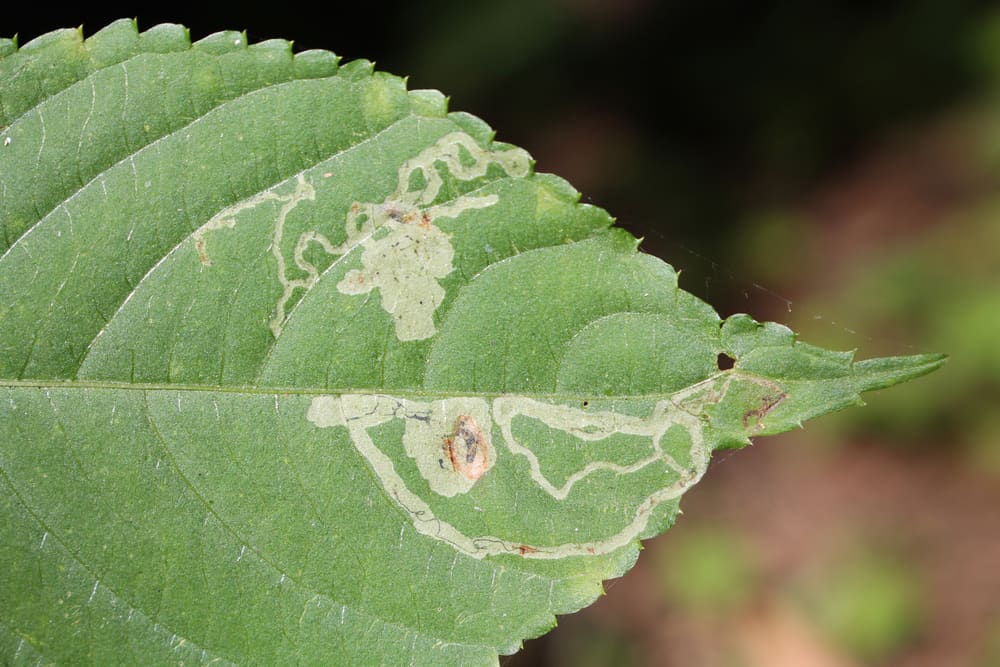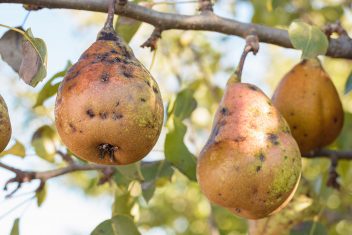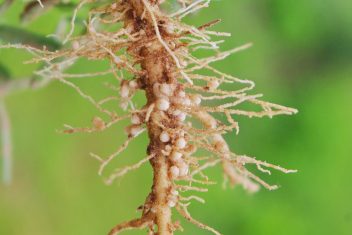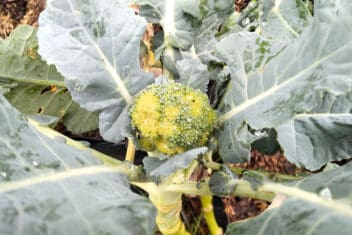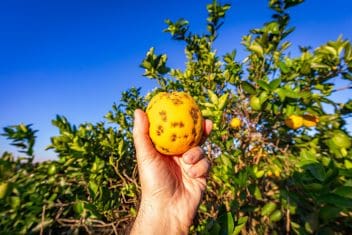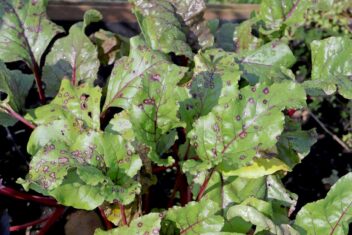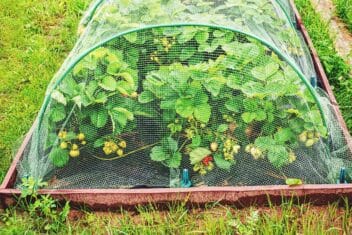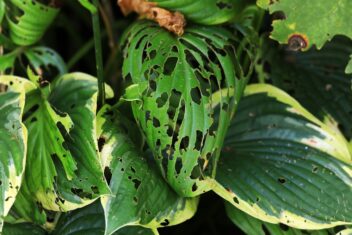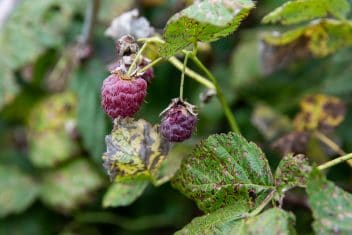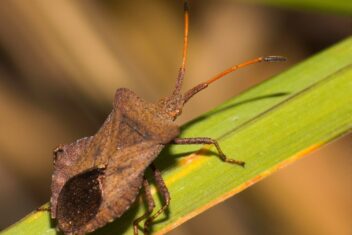Impatiens are versatile plants that offer the gardener an abundance of colorful blooms, even in shady areas. But like many plants, impatiens have issues with pests and diseases. They can be temperamental if not treated right.
Impatiens pests can not only damage or destroy a plant, but they open the door for diseases.
They are a deliciously juicy food source for common pests such as slugs, snails, and whiteflies.
Here are a few more to get to know.
1. Two Spotted Spider Mites
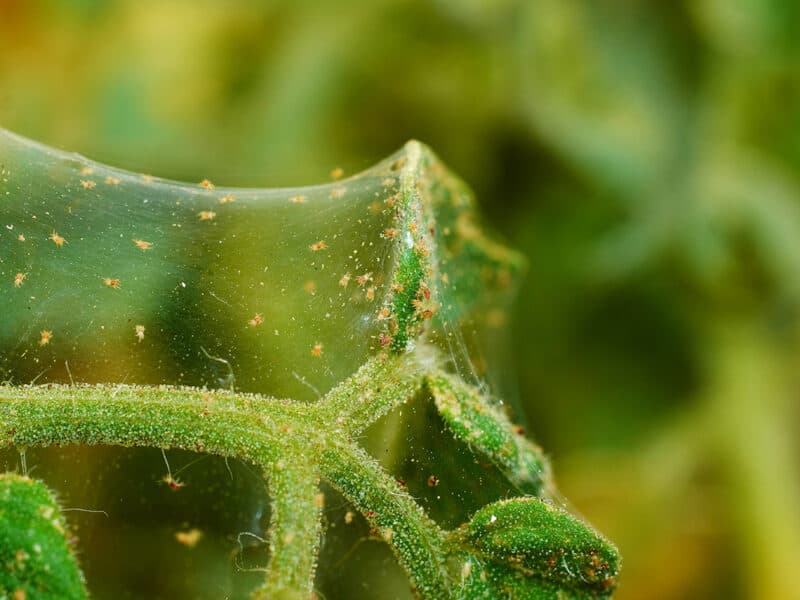
These itty-bitty tick relatives are just 1/25-1/20 inch (0.9-1.25 mm) long. Found throughout North America, Tetranychus urticae spreads quickly, withdrawing the nutrients out of plants with their sucking mouthparts.
Because they reproduce quickly, they can adapt to many pesticides and become resistant. That’s why you must get on top of this ravenous pest quickly before they cause your impatiens to turn brown or yellow and die.
They feed on buds, petals, flowers, foliage, and stems, and young growth.
When they feed, it leaves pale marks on the leaves, and the foliage might be speckled yellow, pale green, and white. The leaves may become mottled. Defoliation may occur in extreme cases.
In the case of a large infestation, if not treated, the impatiens may die.
Life Cycle
- The five-stage life cycle is completed in 5-24 days.
- Eggs laid under leaves in silk webbing.
- Larva hatch in three days.
- Experience two larval stages: protonymph and deutonymph.
- Adult females can live up to 4 weeks and can lay hundreds of eggs during this time.
Preferred Environment
- Greenhouses all year round.
- Likes humidity.
- Temperatures around 80°F.
- Indoor areas.
- Potted plants.
- Vegetable gardens.
- Hides in old debris.
Solutions and Management
A healthy, balanced garden usually has enough beneficial predatory insects to keep a mite infestation in check. If your garden is out of balance, work on restoring it by planting natives and reducing your reliance on insecticides.
You can also introduce predatory mites such as Phytoseiulus persimilis, Neoseiulus californicus, Amblyseius andersoni, Neoseiulus fallacis, Mesosiulus longipes, and Galendromus occidentalis.
Minute pirate bugs, green lacewings, lady beetles, and assassin bugs are also effective predators.
Check the undersides of leaves and squash any eggs. Sweep away any webbing. The mite is at its most vulnerable and detectable at this point. Spray the plants regularly to knock adults and eggs loose.
Clean greenhouses and polytunnels regularly and safely dispose of old garden debris to help control these impatiens pests.
If all else fails, you can spray with insecticidal soaps or oils. Change the product if frequently used, as this pest builds resistance rapidly.
2. American Serpentine Leaf Miner
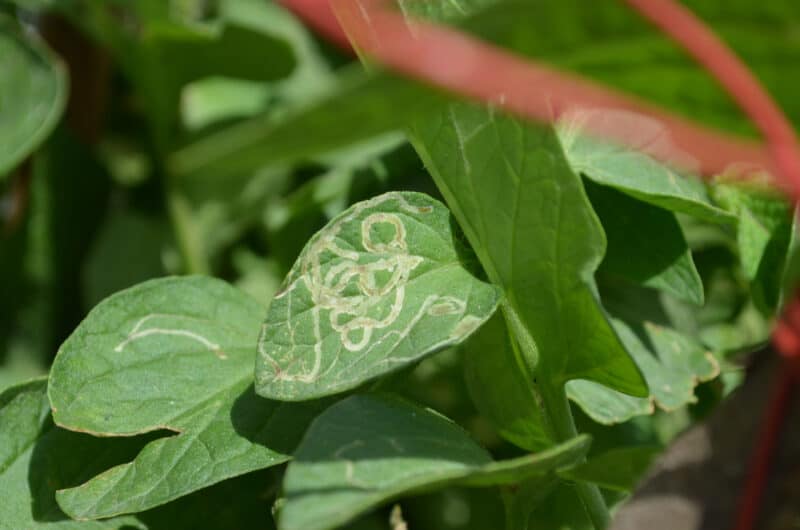
The American serpentine leaf miner (Liriomyza brassicae) is the larvae of a garden fly. The larvae eat inner layers of foliage and blooms, and the adult female fly punctures and sucks nutrients from the plant’s parts.
As the larvae feed, they mine through the inner layers of the leaves, leaving translucent trails behind. They can cause significant damage because these layers prevent photosynthesizing.
Luckily, the adults cannot fly long distances, giving us a fighting chance to control them.
When these impatiens pests are present, you’ll see translucent irregular trails through the foliage and blistering on leaves. The plants may experience stunted growth and premature defoliating. Look for spotted discoloration on the foliage.
Life Cycle
- Cycle completion is two weeks.
- The egg is inserted into the plant by the female.
- Larvae emerge to eat leaf layers.
- Mature larvae stick to foliage to pupate.
- Flies emerge to feed and reproduce.
- Up to ten generations are produced per year.
Preferred Environment
- Loves greenhouses and polytunnels.
- Most commonly found in Eastern North America and Northern South America, but it has recently been located in other areas.
- Heat tolerant.
- Females lay in temperatures between 59-95°F.
- They can be spread by bringing in plants and cut flower arrangements.
Solutions and Management
Encourage or purchase beneficial predators like lady beetles and predatory wasps to control these impatiens pests. You can also grow predator-attracting plants like sweet alyssum, achillea, angelica, cosmos, nasturtiums, prairie sunflower, and marigolds.
Use sprays such as neem oil, abamectin, cyromazine, or spinosad, which are absorbed by the leaves and larvae.
It also helps to plant impatiens an appropriate distance apart and dispose of dropped or decaying foliage to deny these pests a place to hide. Cut off any heavily infested leaves and dispose of them. Don’t put debris in the compost.
3. Cyclamen Mite
Cyclamen mites (Phytonemus pallidus) are slow spreading, but they have a significant impact. They can move between plants easily, sucking up moisture and nutrients. They’re just 0.3 mm long and hide in buds, stamens, and ovaries, so they’re hard to see.
These impatient pests feed on new buds, opening blooms, and new leaf growth. They love New Guinea impatiens (I. hawkeri) particularly.
When they are present, the plant will experience stunted growth due to poor nutrient uptake, and you’ll see curled leaves.
You’ll also see drying foliage, brittle stems, and poor regrowth. New buds might fail to open.
Life Cycle
- The life cycle is complete in one to three weeks.
- Adults overwinter outside.
- Heat sensitive, death occurs at 110°F.
- Eggs opaque and soft, rounded ends.
- Larvae use sucking mouthparts to feed.
- Adult females yellowish brown.
- Females lay three eggs daily, about 16 in lifespan.
- Larvae have three pairs of legs.
- Adults have four pairs of legs.
- Numerous generations are produced each year.
Preferred Environment
- Widespread throughout North America.
- Thrives in temperatures around 60°F.
- The population explodes in greenhouse conditions.
- Prefers relative humidity of 80-90%.
Solutions and Management
Because these impatiens pests can hitch a ride, you must practice good tool hygiene. If you know you’ve been in an area where they’re present, use a preventative miticide spray on your plants.
Mites can be killed if exposed to water that is 110°F, but this kind of heat will likely kill your impatiens, too. Use soap and hot water on your tools, not your plants. Clean greenhouses and polytunnels regularly.
Isolate infested plants and apply insecticidal soap once a week for several weeks.
4. Citrus Mealybug
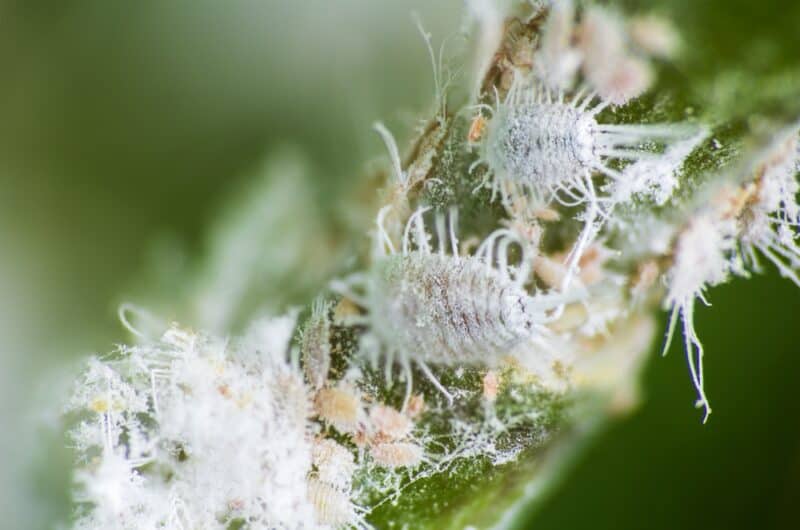
The citrus mealybug (Homoptera pseudococcidae) spreads en mass, which means that though they’re small, they are high-impact impatiens pests. The males can fly, making it even easier to spread around.
These impatiens pests hide on the underside of leaves or crevices and feed on foliage, flowers, and stems, sucking out the nutrients at moisture with their mouthparts.
They are ravenous, and as they eat, they excrete a sticky sap that attracts sooty mold. These pests eat the foliage, stems, branches, buds, and blooms. They like to hide out under the leaves or in other concealed areas.
These impatiens pests prefer stressed and nitrogen-rich plants, but all impatiens will do.
Look out for yellowing leaves, wilting and a general lack of luster. Sooty mold and an increase in ant activity is also a warning sign. In bad cases, the plant might die.
Life Cycle
- Males mature in cocoons and fly to mate.
- Females lay 400-600 tiny eggs.
- Eggs laid in one clump, in a nest of white wax.
- In warm climates, they can give birth to live young rather than eggs.
Preferred Environment
- Prefers New Guinea impatiens.
- Infests greenhouses.
- It can be found globally.
Solutions and Management
Encourage or purchase natural predators such as lady beetles, lacewings, spiders, pirate bugs, and predaceous midges larvae.
To prevent these impatiens pests, check new plants before you bring them home, and avoid over-fertilizing and over-watering.
Wipe away these impatiens pests with cotton swabs soaked in rubbing alcohol.
5. Black Vine Weevil

Black vine weevils (Otiorhynchus sulcatus) impact the plant both above and below ground. The larvae eat new roots, and the adolescent stage eats the more established roots. Wet soil drives larvae out to eat stems. Adults nibble the outer edges of leaves.
These impatiens pests reproduce asexually, meaning they are parthenogenetic. They’re also nocturnal and unable to fly, but they’re good walkers and climbers. The larvae emerge in spring when the weather warms, as they cannot regulate their temperature.
Watch out for small, irregular bites on leaves and stunted new growth due to the feeding below the soil. Your impatiens may fail to thrive and will wilt or even die.
Life Cycle
- Four stages: egg, larvae, pupal instar, adult.
- Outdoors one cycle per year.
- Multiple cycles in greenhouses.
Preferred Environment
- Found in containers, greenhouses, and polytunnels, as well as garden beds.
- Survive winters as larvae in soil 1-8 inches down.
- Widespread from Maine to the Carolinas and west to Washington and Oregon.
- Prefers temperatures 50-97°F.
- Likes heavy, moist soil and mulch.
Solutions and Management
Diatomaceous earth is an excellent first defense. Sprinkle it around plants to kill the emerging larvae. Since they’re nocturnal feeders, check your plants at night and drown any adults in soapy water.
At dusk, you can also spray infested plants with a contact insecticide. Remove any mulch to deny the pests a place to hide.
Finally, use beneficial nematodes to combat developing larvae.
6. Aphids
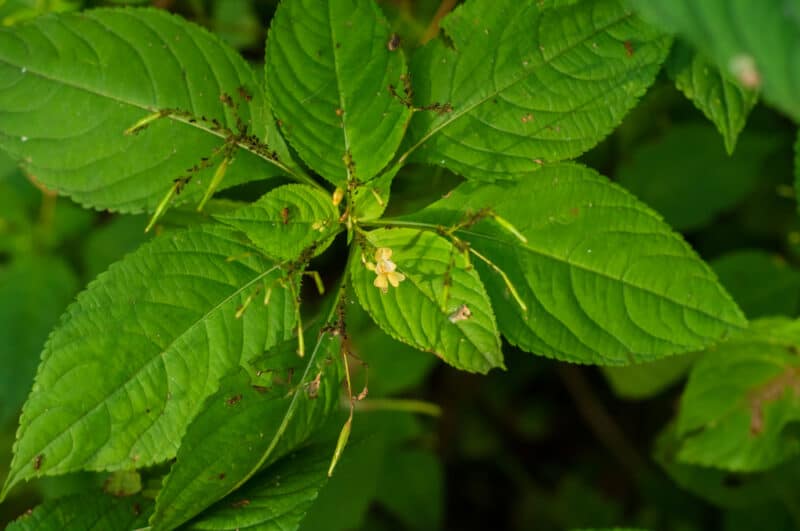
Aphids breed rapidly, and you often won’t even know they’re around until they’ve exploded in population. They hide under foliage and collect on developing buds. Some can fly, while others are flightless.
These impatiens pests use their piercing mouthparts to suck the sap out of the plant, spreading viruses as they go.
They also attract ants and sooty mold with the sticky honeydew secretions that they leave behind.
Watch for them on new growth, buds, and blooms. They love young seedlings and cuttings and cluster on stems and under the foliage.
When present, these impatiens pests cause curling or discolored leaves, wilting, and even defoliation.
Life Cycle
- Complete in a month.
- Mature in four to ten days.
- Reproduce at maturity.
- Female lives for 25 days, produce up to 80 aphids in this time.
- Reproduce asexually in spring with warmer temperatures.
- Produce clones spring to summer and offspring are born live.
Preferred Environment
- Greenhouses and polytunnels.
- Eggs survive winter conditions.
- Temperatures 60-90°F.
- Nitrogen-rich plants.
Solutions and Management
Grow plants that deter aphids or can act as trap crops, like marigolds, onions, catnip, dill, peppermint, chives, or fennel.
At the same time, buy or encourage predators like lady beetles, lacewing larvae, birds, predatory mites, parasitic wasps, rove beetles, and hoverfly larvae.
It’s often effective for small infestations to simply spray them off with a steady stream of water. Do this every week. If that doesn’t take care of it, head to our guide for more tips.
7. Thrips
Impatiens thrips (Echinothrips americanus) are a challenge to deal with. The adults can fly, and others can transfer on the wind. They’re also spread by plant movement, so checking new plants before you bring them home is vital.
These impatiens pests are attracted by blue and yellow, in particular. When they find a plant they like, they use their mouthparts to suck out the plant’s sap from the leaves.
Once these impatiens pests settle in and start feeding, you’ll notice silvery speckles, stunted growth, and disfigured flowers. You might also see streaks or white spots and shriveling foliage.
The plants will lose vigor due to the loss of chlorophyll.
Life Cycle
- Six stages, which are completed in two weeks.
- Eggs are inserted into leaf layers.
- 150-300 eggs laid that hatch 3-5 days.
- Two larval instars: prepupa and pupa.
- Adults, both male and female, can replicate asexually.
Preferred Environment
- Native to North America and around the globe.
- They prefer greenhouses and polytunnels.
- House plants.
- Potted and cultivated plants.
- Temperatures of 50-98°F.
Solutions and Management
Encourage predatory insects like predatory mites such as Orius majusculus and Dicyphus maroccanus, pirate bugs, ladybugs or lady beetles, green lacewings, and Trichogramma wasps.
You can also add plants that thrips avoid, like basil, chives, catnip, and garlic.
Finally, spray the plants with insecticides that contain pyrethrin. You can also use insecticidal soap, but take care to apply it thoroughly to the underside of the leaves.
8. Root-Knot Nematodes
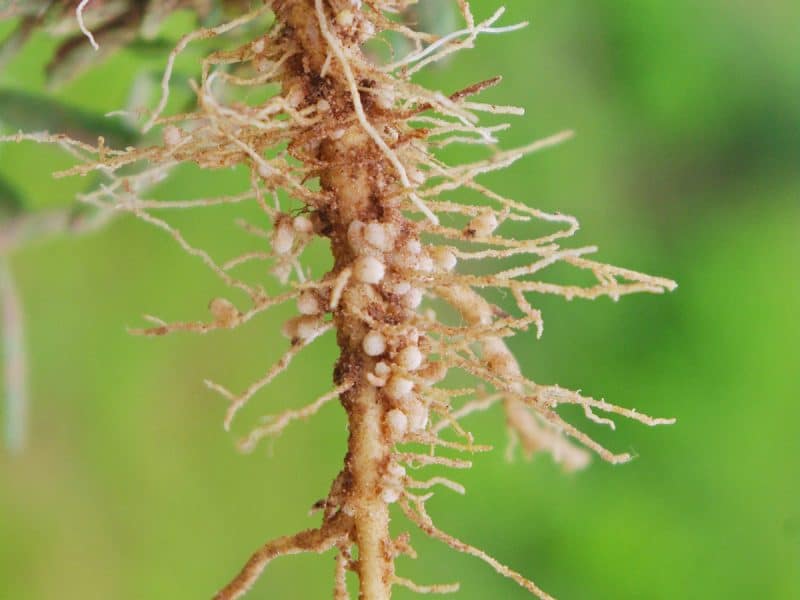
Root-knot nematodes (Meloidogyne incognita) are microscopic plant-parasitic worms that occur across the globe.
These impatiens pests live in the soil, where they feed on the roots of many different species, causing all kinds of problems.
There are not to be mistaken with friendly, soil micronutrient balancing nematodes. We want those in our garden.
If you have root-knot nematodes, you’ll likely see stunted growth, wilting, and yellowing leaves. You might have even purchased an infested plant if it starts struggling after you put it in the ground.
There will be a lack of improvement after feeding with fertilizer or watering.
Life Cycle
- Full cycle completed in 3-5 weeks.
- Eggs are laid on the root surface with a protective gel around them.
- Survive winter as eggs in soil.
- Mature females lay between 150-1500 eggs each time.
Preferred Environment
- Soil temperatures 77-86°F.
- Infects plants if cultivated with infested soil.
Solutions and Management
Good garden hygiene is a must in controlling these impatiens pests. It’s always a smart idea, but especially so with preventing this pest. Clean all tools and machinery that dig into the soil, and clean your footwear.
They can be spread by animals and running water.
Dispose of unhealthy plants even at the seedling stage, and don’t plant in an area with previous infestations.
If you find that you have an infestation, use a nematicide drench. Be sure to follow the manufacturer’s directions.
If you’re growing in a container, you can sterilize the soil by baking it in an oven before using it. Root-knot nematodes and eggs cannot survive temperatures exceeding 125°F for 30 minutes or more or 130°F for 5 minutes.
You can also use pre-planting soil treatments.
Suppressing plants for root-knot nematodes that break nematode life cycles are:
For more tips, visit our guide.
